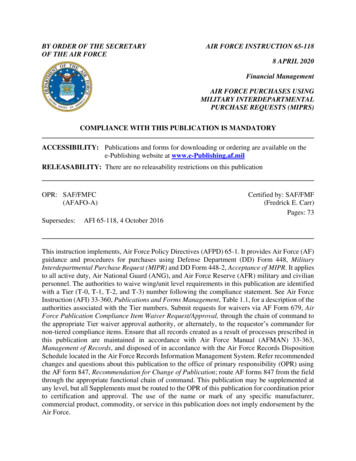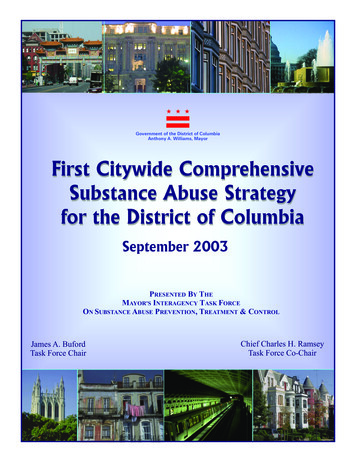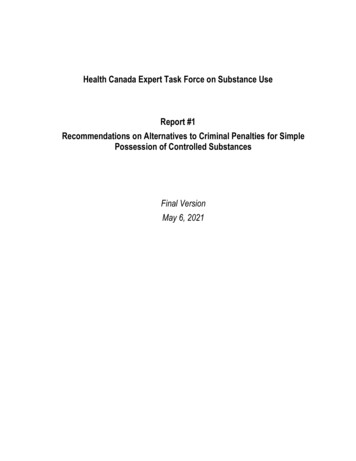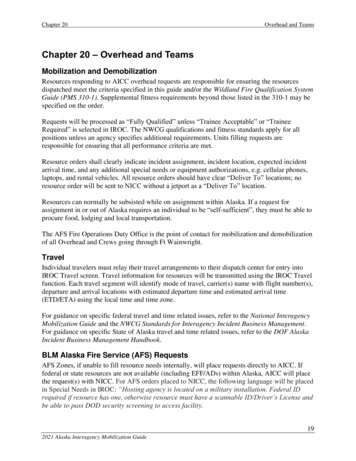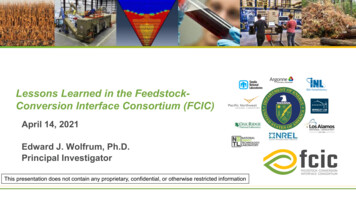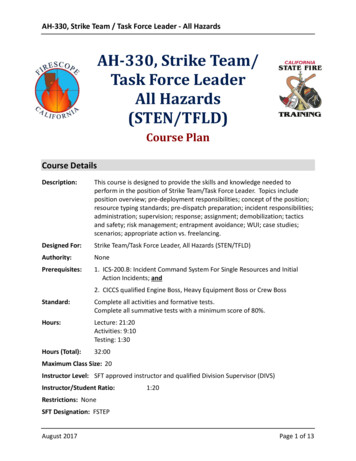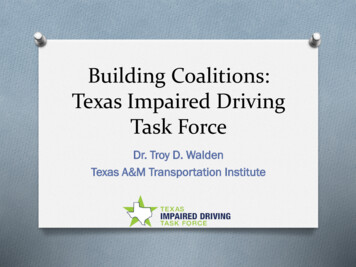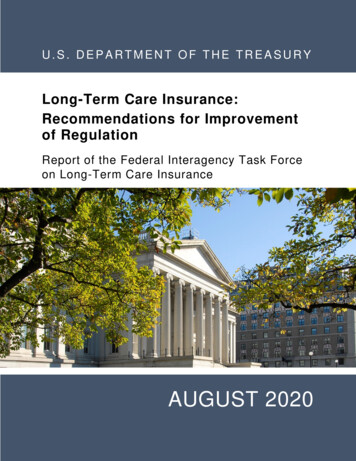
Transcription
U.S. DEPARTMENT OF THE TREASURYU.S. DEPARTMENT OF THE TREASURYLong-Term Care Insurance:Recommendations for Improvementof RegulationReport of the Federal Interagency Task Forceon Long-Term Care InsuranceAUGUST 2020Long-Term Care Insurance: Recommendations for Improvement of Regulation i
U.S. DEPARTMENT OF THE TREASURYLong-Term Care Insurance:Recommendations for Improvement ofRegulationReport of the Federal Interagency Task Force onLong-Term Care InsuranceSteven T. MnuchinSecretaryMichael FaulkenderAssistant Secretary for Economic Policy
AcknowledgmentsThe Federal Interagency Task Force on Long-Term Care Insurance consists of representativesfrom the U.S. Department of the Treasury (Treasury), the U.S. Department of Health and HumanServices (HHS), the U.S. Department of Labor (DOL), and the Office of Management andBudget (OMB). Secretary Mnuchin and Treasury Assistant Secretary Michael Faulkender wouldlike to thank the following individuals for their service as members of the Task Force and theircontributions to this report:Treasury: Jason Brown, Diana Furchtgott-Roth, Anne Hall, Alex Hart, Eda Herzog-Vitto, GillianHunter, Louisa Quittman, Shanthi Ramnath, Bruce Saul, Steven Seitz, Angela Walitt, and HarlanWellerHHS: William Marton and Mary NugentDOL: Jeanne Klinefelter WilsonOMB: Amy Batchelor and Rebecca SpavinsSecretary Mnuchin and Assistant Secretary Michael Faulkender would also like to thankTreasury staff members Bruce Saul and Elizabeth Sawyer for supporting the Task Force andleading Treasury staff’s work on the report.
Table of ContentsExecutive Summary .1Introduction . 1Scope and Objectives of the Task Force . 2Long-Term Care Insurance in the United States. 2Review of the Process for this Report. 3Summary of Analysis and Recommendations . 4The Role of Insurance in Long-Term Care .10Prevalence of Need for LTSS . 10Projections of Demand for LTSS . 12Financing of LTSS . 14Factors Impeding the Market for Private LTCI . 19Innovation and Product Development .23Combination Products. 23Other New Product Designs. 27Regulatory Efficiency and Alignment .34Inflation Protection . 34Other Consumer Protections . 37Review and Approval of Rate Increases . 37Financial Literacy and Education .40Reviewing the Federal Role in Financial Education. 40Stakeholder Recommendations Relating to Education . 41Best Practices for Financial Education . 42Tax Incentives .44Current Tax Rules Regarding LTCI . 44Analysis of Tax Incentives Considered . 48Alternative Financing Approaches .55Front-End Benefit Options . 55Back-End (Catastrophic) Options . 58Comprehensive Options . 59Long-Term Care Insurance: Recommendations for Improvement of Regulation iv
Appendices .60Appendix A: Participants in the Engagement Process . 60Appendix B: Summary of Analysis and Recommendations. 61Long-Term Care Insurance: Recommendations for Improvement of Regulation v
AbbreviationsAcronymAbbreviationACIAnnual Compound InflationADLsActivities of Daily LivingAGIAdjusted Gross IncomeCBOCongressional Budget OfficeCDCCenters for Disease Control and PreventionCMSU.S. Department of Health and Human Services, Centers forMedicare & Medicaid ServicesCodeInternal Revenue CodeDOLU.S. Department of LaborDRADeficit Reduction Act of 2005EBSAU.S. Department of Labor, Employee Benefits SecurityAdministrationEPDVExpected Present Discounted ValueERISAEmployee Retirement Income Security Act of 1974FIOU.S. Department of the Treasury, Federal Insurance OfficeFLECFinancial Literacy Education CommissionFSAFlexible Spending ArrangementHDHPHigh-Deductible Health PlanHHSU.S. Department of Health and Human ServicesHIPAAHealth Insurance Portability and Accountability Act of 1996HRSHealth and Retirement StudyHSAHealth Savings AccountIADLsInstrumental Activities of Daily LivingIRAIndividual Retirement AccountLTCLong-Term CareLTCILong-Term Care InsuranceLong-Term Care Insurance: Recommendations for Improvement of Regulation v
AcronymAbbreviationLTCI Model ActNAIC Long-Term Care Insurance Model ActLTCI Model RegulationNAIC Long-Term Care Insurance Model RegulationLTCSALong-Term Care Savings AccountLTSSLong-Term Services and SupportsMAMedicare AdvantageNAICNational Association of Insurance CommissionersNAIC 2017 ListLong-Term Care Federal Options Presented by the NAIC in April2017NHEANational Health Expenditure AccountsPartnership programPartnerships for Long-Term Care Federal-State ProgramSECURE ActSetting Every Community Up for Retirement and Enhancement Actof 2019SOASociety of ActuariesSSAU.S. Social Security AdministrationTask ForceFederal Interagency Task Force on Long-Term Care InsuranceTreasuryU.S. Department of the TreasuryLong-Term Care Insurance: Recommendations for Improvement of Regulation vi
Executive SummaryIntroductionIn July 2018, the U.S. Department of the Treasury (Treasury) convened a federal interagencytask force on long-term care insurance (Task Force) in response to recommendations inTreasury’s October 2017 Report on Asset Management and Insurance (Insurance Report). 1 TheInsurance Report identified the challenges of financing long-term care (LTC) as a matter ofnational interest requiring a coordinated response from the federal government, while affirmingthe primary role of the U.S. states as insurance regulators in the United States. Accordingly, theInsurance Report recommended that Treasury convene the Task Force to develop policies tocomplement reforms at the state level relating to the regulation of long-term care insurance(LTCI). The Insurance Report stated that the Task Force should coordinate its work with theongoing work of state insurance regulators and the National Association of InsuranceCommissioners (NAIC). 2The Task Force consists of representatives from Treasury’s Office of Economic Policy(including the Assistant Secretary for Economic Policy, who chairs the Task Force); otherTreasury offices (Tax Policy, Consumer Policy, and the Federal Insurance Office (FIO)); theU.S. Department of Health and Human Services (HHS); the Centers for Medicare & MedicaidServices (CMS); the U.S. Department of Labor (DOL); and the Office of Management andBudget.Since its inception in 2018, the Task Force has identified and analyzed proposed reforms to theregulation of LTCI and consulted with a range of stakeholders. The Task Force concludes thatLTCI can play a role in providing financial protection against LTC risks and helping individualsplan their financial future. To that end, this report describes the work conducted by the TaskForce and presents its recommendations to improve the regulation of LTCI in the United States.In making these recommendations, the Task Force does not intend to either promote ordiscourage LTCI over other solutions to the challenges of financing LTC. Implementation of therecommendations will remove barriers to innovation and increase regulatory efficiency andalignment, potentially making LTCI more affordable and accessible while allowing the market tocontinue shaping the evolution of this product line.1U.S. Department of the Treasury, A Financial System That Creates Economic Opportunities: Asset Managementand Insurance (Treasury, October 2017), 163 [hereinafter Insurance Report], available onomicOpportunities-Asset Management-Insurance.pdf.2Treasury, Insurance Report, 144. The NAIC is the U.S. standard-setting and regulatory support organizationcreated and governed by the chief insurance regulators from the 50 states, District of Columbia, and five U.S.territories.Long-Term Care Insurance: Recommendations for Improvement of Regulation 1
Scope and Objectives of the Task ForceThe Task Force determined that its primary objectives were to analyze, evaluate, and makerecommendations concerning: The LTC federal policy options presented to federal agencies and Congress by the NAICin April 2017 (NAIC 2017 List); 3 Other potential new federal policies, or modifications of existing policies, to complementstate-based regulation of LTCI; and The manner and degree to which current laws and regulations appropriately recognizeand respond to newer product designs and features in the LTCI market.In conducting its work, the Task Force focused on federal laws and regulations relating to theprivate insurance market. The Task Force also examined certain state laws and regulations,primarily those referenced in federal laws.The Task Force substantially completed its analysis and recommendations prior to the onset ofthe COVID-19 pandemic. The pandemic is likely to affect the provision of LTC and the marketfor LTCI, but the full effects will continue to emerge over time. 4 For these reasons, this reportdoes not seek to assess the potential impacts of COVID-19 on LTC or LTCI.Long-Term Care Insurance in the United StatesThe terms “long-term care” (LTC) and “long-term services and supports” (LTSS) cover a rangeof services provided to people with long-term physical or cognitive limitations. The privateinsurance industry typically uses LTC as a shorthand term, while academic and public policyliterature, as well as some governmental publications, typically use LTSS. With someexceptions, this report generally adopts LTC. 5Most LTC is not medical care, but rather assistance with the basic personal tasks of everydaylife, such as bathing, dressing, using the toilet, transferring (to or from bed or a chair), caring for3National Association of Insurance Commissioners, Long-Term Care Innovation (B) Subgroup: Federal PolicyOptions to Present to Congress (Kansas City: NAIC, April 2017), 2, available at:https://www.naic.org/documents/cmte e res mech wg related federal policy issues.pdf.4Treasury will continue to monitor the effects of COVID-19 on insurance products and markets, including LTCI.COVID-19 disproportionally affects older adults and individuals with chronic illnesses or other high-risk healthconditions, making the LTC population (particularly those in nursing homes or assisted living facilities) morevulnerable to the virus than the general population. Relevant factors with respect to the pricing of LTCI includemortality, policy lapses, the incidence of claims, utilization of benefits, and changes in interest rates. See AndrewDalton et al., “Pandemic Risk on LTC Insurance Reserves,” Milliman, April 2020, available k-on-ltc-insurance-reserves.5The Role of Insurance in Long-Term Care and the Alternative Financing Approaches sections generally adoptLTSS.Long-Term Care Insurance: Recommendations for Improvement of Regulation 2
incontinence, and eating. 6 Approximately half of Americans turning age 65 today will needsome type of LTC in their lives. The older a person is, the more likely it is that he or she willneed LTC at some point. The Congressional Budget Office (CBO) has projected that U.S.spending on LTC for the elderly (age 65 and above) will increase from 1% of gross domesticproduct in 2010 to 3% in 2050.Based on data from the National Health Expenditure Accounts (NHEA), the Medicaid programwas the largest payer of LTSS expenses in 2018 (total payments of 159.1 billion), followed byout-of-pocket spending by individuals ( 55.0 billion). By contrast, based on industry data,private LTCI paid 10.3 billion in claims in 2018.Private insurers began offering LTCI in the 1970s in response to demand for financial protectionagainst the risk of having to enter a nursing home. Sales of new policies peaked in the early2000s, but have since declined as numerous insurers decided to exit the market due to the poorfinancial performance of the product line. The market remains in flux, with sales of traditional,standalone LTCI continuing to drop while “combination” insurance products have become morepopular with consumers. 7 The role of the private insurance market in addressing the growingneed for LTC will largely depend on the four main subject areas examined in this report:innovation in product design and delivery; the efficiency and effectiveness of regulation;education and awareness with respect to LTC needs and planning; and federal income taxtreatment of LTCI.Review of the Process for this ReportFor this report, the Task Force consulted with a wide range of stakeholders, including consumerand other advocacy groups, trade groups, insurance companies and insurance productdistributors, actuaries, academics, legal experts, state insurance regulators, the NAIC, and otherstakeholders with relevant knowledge. See Appendix A for a list of organizations and individualsproviding input to the Task Force. The Task Force also reviewed data, research, andpublications from both public and private sector sources.On July 25, 2019, the Task Force held a public meeting at Treasury to obtain additional input forthis report. Topics discussed at the meeting included the social need for LTC; the individualprivate LTCI market; employer, group, and worksite LTCI products; state regulation of LTCI;the federal government and LTCI; and federal-state partnerships and other financing approaches.6“Long-Term Care – The Basics – What is Long-Term Care?” LongTermCare.gov, U.S. Department of Health andHuman Services, last modified October 2017, available at: ngterm-care.html.7In this report, “traditional” or “stand-alone” LTCI refers to policies that provide only LTCI coverage, asdistinguished from “combination” policies or other product designs that combine LTCI with other coverages, suchas life insurance or an annuity.Long-Term Care Insurance: Recommendations for Improvement of Regulation 3
Through a posting on Treasury’s website and an announcement at the public meeting, the TaskForce offered the public an opportunity to provide written comments. The Task Force receivedcomments from a total of 16 consumers and consumer advocacy groups, actuarial organizations,and industry experts and consultants. 8 This report addresses several recommendations from thecomments, and incorporates certain data and other information provided by commenters.Summary of Analysis and RecommendationsThe Task Force organized its analysis and recommendations into four subject areas: Innovation and Product Development – product development and other innovation inthe private market, including policies that combine LTCI with other types of insuranceproducts or product features offering alternatives to traditional, stand-alone LTCI. Regulatory Efficiency and Alignment – improvements in regulatory efficiency andalignment with respect to LTCI, including inflation protection requirements, harmonybetween federal and state laws and regulations, and cross-state subsidization and otherissues relating to state regulatory review and approval of premium increases. Financial Literacy and Education – the appropriate federal role in financial literacy andeducation relating to LTC needs and LTCI. Tax Incentives – current tax law treatment of LTCI and proposals to provide additionaltax incentives for the purchase and use of LTCI.Although public programs providing LTC benefits were not in scope for specificrecommendations, the Task Force also reviewed several proposed public insurance options asdescribed in the Alternative Financing Approaches section of this report.Appendix B presents the analysis and recommendations of the Task Force and identifies thepolicymakers and other stakeholders the Task Force considers well positioned to implement eachrecommendation. Following publication of this report, Treasury will continue to monitorimplementation of the recommendations.Innovation and Product DevelopmentIn response to the decline in the market for traditional LTCI, insurers have introduced alternativeproduct designs and new features to both increase the consumer appeal of LTCI and improve thefinancial returns on LTCI for insurers. These designs and features include combination products,limited LTCI, group products, and incidental benefits.Innovation and product development have the potential to significantly strengthen the privateLTCI market and better address the LTC needs of consumers. Accordingly, the Task Force8See “Public Comments Received by the Task Force,” U.S. Department of the Treasury, August 2019, available rm Care Insurance: Recommendations for Improvement of Regulation 4
recommends that federal and state policymakers foster a regulatory environment that encouragesflexibility, experimentation, and innovation in product design to improve consumer choice andaccess to benefits, while appropriately protecting the rights of consumers and the solvency ofinsurers.Combination ProductsInsurers have introduced a variety of products that combine LTCI with different types ofinsurance, primarily life insurance and annuities. These combination products offer potentialadvantages to consumers and insurance distributors, but also present challenges for these groupsdue to their complexity and the wide range of combinations available. Although claimsexperience on these relatively new products is limited, companies report that the incidence ofclaims and other actuarial results to date have been positive.Policymakers could benefit from analysis of the impact of combination products on the marketfor LTCI risk protection. The Task Force recommends that actuaries, academics, and otherstakeholders explore such an analysis, with coordination by FIO.Limited LTCI ProductsCompared to traditional LTCI, “short” or “limited” LTCI policies (i.e., policies that pay benefitsfor less than 12 months) generally have lower benefits, but also typically have no deductible orwaiting period, as well as less stringent underwriting and lower premiums. Because limitedLTCI emerged later than traditional LTCI, regulation of this market is less mature than thetraditional market. In late 2018, the NAIC adopted a model act and model regulation for thisproduct. However, the states generally have not yet adopted either model.The Task Force recommends that federal policymakers work with their state counterparts andwith private sector stakeholders to evaluate and monitor the market for limited LTCI, includingpotential impacts on the risk pool for longer-term products and on Medicaid. The Task Forcefurther recommends that state legislators and insurance regulators take steps to better streamlineand standardize the regulation of this market.Group ProductsThe Task Force considered two policy proposals for LTCI group products that were includedunder the NAIC 2017 List, both involving the fiduciary provisions of the Employee RetirementIncome Security Act of 1974 (ERISA). The first proposal is to create a safe harbor to removepotential exposure to ERISA fiduciary liability as a factor in employers’ decisions not to offerLTCI to employees. The second proposal is to permit 401(k) and individual retirement account(IRA) participants to purchase LTCI within their accounts. The objective of both proposals is topromote a more viable group LTCI market by increasing employee participation, resulting in alarger and more favorable risk pool for insurers and, potentially, lower premiums.Long-Term Care Insurance: Recommendations for Improvement of Regulation 5
Based on stakeholder input and an assessment of the market and legal landscapes for theemployer market, the Task Force does not recommend either option because it is uncertainwhether either proposal would have a meaningful impact on participation levels.Incidental BenefitsUnder most LTCI policies, the insured is not eligible to submit a claim for benefits until he orshe becomes “chronically ill” as defined under state insurance laws and the Internal RevenueCode (Code). Some stakeholders proposed that Congress should amend the Code to permitpayment of incidental benefits (such as home assessments to identify safety hazards, homemodifications, or caregiver training for family members) from a LTCI policy prior to the onset ofchronic illness, without causing the policy to forfeit its tax-qualified status.Supporting the ability of those needing LTC to remain in their homes could benefit bothconsumers and insurers. Accordingly, the Task Force encourages industry, federalpolicymakers, and other experts, in consultation with consumer representatives, to identify andassess research-based evidence of cost-effective interventions. If cost-effective incidentalbenefits are identified, Congress could consider amending the Code to permit payment of thosebenefits under a tax-qualified LTCI contract prior to the insured becoming chronically ill, subjectto a monetary cap and other conditions set by regulation.Regulatory Efficiency and AlignmentThe Task Force considered various recommendations to improve the efficiency and effectivenessof regulation of LTCI at the federal and state levels, including federal policies identified in theNAIC 2017 List.Inflation Protection Under the Health Insurance Portability and Accountability Act of 1996(HIPAA)Because LTCI policies often remain in force for many years, purchasers of LTCI face asignificant risk that inflation will erode the value of their benefits over time. Under current statelaws and regulations, insurers must offer policyholders the right to purchase a policy feature thatincreases benefits at an annual compounded rate not less than 5%. In 2006, when it codifiedrequirements for tax-qualified LTCI as part of HIPAA, Congress incorporated the 5% compoundstandard through reference to the 1993 version of the NAIC Long-Term Care Insurance ModelRegulation (LTCI Model Regulation). 9The NAIC and Congress based the 5% compound inflation standard on inflation rates thatprevailed in the 1980s and 1990s. Since then, particularly following the financial crisis, thisstandard has become a costly feature that increases premiums to levels most consumers will not9HIPAA amended the Code to add Section 7702B, which sets forth the requirements for a “qualified long-term careinsurance contract.” See 26 U.S.C. § 7702B(a)(1).Long-Term Care Insurance: Recommendations for Improvement of Regulation 6
accept. The Task Force concludes that inflation protection requirements under HIPAA and stateinsurance laws should be revised to increase the efficiency and effectiveness of regulation.To both address outdated inflation protection requirements and provide flexibility to adaptinflation protection to evolving economic conditions, the Task Force recommends that Congressamend the Code to authorize Treasury to set inflation protections for tax-qualified LTCI.Inflation Protection Under the DRAIn the early 1990s, four states (California, Connecticut, Indiana, and New York) implemented afederal-state program known as “Partnerships for Long-Term Care” (Partnership program). Aspart of the Deficit Reduction Act of 2005 (the DRA), Congress extended the Partnershipprogram nationwide, subject to specified conditions including inflation protection and otherconsumer protections. 10 The states have adopted widely varying inflation protectionrequirements for LTCI policies under the Partnership program, resulting in a regulatorypatchwork with uneven consumer protections and additional complexity that makes it moredifficult to write LTCI. Additionally, high inflation protection mandates in some states mayraise the costs and reduce the attractiveness of Partnership policies.The Task Force recommends that state policymakers—legislators, state Medicaid directors,insurance commissioners, and the NAIC—improve regulatory efficiency and effectiveness byharmonizing and streamlining inflation protection requirements under the Partnership program.Alternatively, Congress should consider delegating to HHS the authority to set Partnershipprogram inflation protection requirements.Other Consumer ProtectionsApart from inflation protection, both HIPAA and the DRA mandate compliance with certainconsumer protections contained in the NAIC Long-Term Care Insurance Model Act (LTCIModel Act) and the LTCI Model Regulation. However, the DRA defines “model regulation”and “model Act” by reference to the NAIC models adopted as of October 2000, while HIPAAdefines these terms by reference to the January 1993 versions. This cross-referencing in twofederal statutes of two outdated and conflicting versions of NAIC models creates confusion andadds complexity to conducting LTCI business.The Task Force recommends that Congress consider options to address this regulatoryinefficiency. For example, as one option, Congress could consider giving Treasury the authority,in consultation with HHS, to set consumer protection standards using one version of the LTCIModel Act and LTCI Model Regulation for purposes of both tax qualification under HIPAA andPartnership eligibility under the DRA, with flexibility to update the standards periodically (e.g.,every 10 years).10See 42 U.S.C. § 1396p.Long-Term Care Insurance: Recommendations for Improvement of Regulation 7
Review and Approval of Rate IncreasesThe authority of state insurance regulators to review and approve proposed rate increases forLTCI before the insurer implements those changes is a critical factor in the LTCI marketplace.Due to the non-uniform nature of the state-by-state rate increase process, policyholders in stateswhere regulators have approved rate increases may subsidize the cost of premiums forpolicyholders in other states where regulators have either approved limited increases or rejectedrate increases in their entirety.In 2019, the NAIC identified the regulation of LTCI as the organization’s top priority. The TaskForce recommends that the NAIC and the states maintain their focus on LTCI and continueworking together in 2020 to develop a consistent national approach to regulatory reviews ofLTCI rate increase requests. The Task Force also recommends that FIO continue to monitor andreport on this issue.Financial Literacy and EducationThe NAIC 2017 List included a federal education program around retirement security and theimportance of planning for potential LTC needs. In 2019, Treasury released a report (FinancialLiteracy Report), laying out an appropriate federal role for financial education based on aliterature review and consultations with experts and stakeholders inside and outside of thegovernment. 11 In the Financial Literacy Report, Treasury recommended that the primary federalrole in this area should be to empower financial education providers, as opposed to attempting toreach every American household directly.The Task Force recommends that Treasury, HHS, DOL, and other agencies, working through theFinancial Literacy Education Commission (FLEC), assess federal education resources on LTCneeds and planning, and modify, update, and supplement these resources as needed.Tax IncentivesThe NAIC 2017 List included consideration of more generous tax incentives for the purchase ofLTCI. Multiple stakeholders encouraged the Task Force to consider a range of amendments totax laws or regulations aimed at increasing the take-up of private LTCI. The Task Forceanalyzed several potential new tax incentives and other potential tax reforms.In its analysis, the Task Force took into account that the Code already provides favorable incometax treatment to LTCI. The Task Force concludes that the pro
Long-Term Care Insurance in the United States The terms "long-term care" (LTC) and "long-term services and supports" (LTSS) cover a range of services provided to people with long-term physical or cognitive limitations. The private insurance industry typically uses LTC as a shorthand term, while academic and public policy

